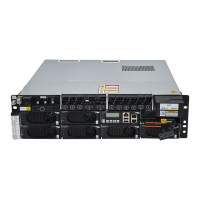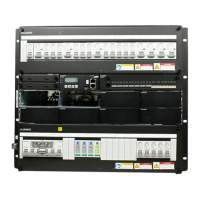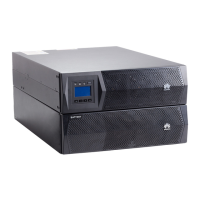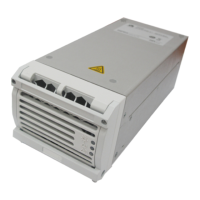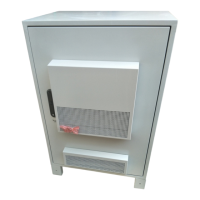Do you have a question about the Huawei V100R021C10 and is the answer not in the manual?
Personal safety precautions for installation, operation, and maintenance.
Electrical safety precautions, grounding, and cabling guidelines.
Specifies environmental conditions for equipment storage and operation.
Safety measures for mechanical operations, including moving heavy objects and using ladders.
Safety guidelines for specific equipment like UPS, cooling systems, and batteries.
Safety guidelines specific to Uninterruptible Power Supply (UPS) units.
Safety precautions for high temperature, pressure, and refrigerant handling.
Critical safety guidelines for handling and installing batteries to prevent hazards.
Lists general tools and instruments required for installation.
Ensures the installation environment meets specified requirements before installation.
Details specific field requirements for installation.
Lists related documents required before installation.
Describes various installation scenarios for reference.
Specifies requirements for personnel performing installation and operation.
Procedures for safely moving and unpacking equipment components.
Specific steps for moving and unpacking smart cooling products.
Procedures for moving and unpacking smart module components.
Procedures for installing cabinets into the system.
Steps for safely moving the Power Distribution Frame (PDF).
Steps for safely moving an IT cabinet.
Procedures for installing various components within cabinets.
Steps for installing components specific to IT cabinets.
Optional installation of side panels for IT cabinets.
Procedures for installing optional bases for cabinet stability.
Precautions for correctly installing cabinet bases.
Steps for installing bases with adjustable dimensions.
Optional procedure for managing rPDU cables.
Optional installation of a horizontal ground bar.
Optional installation of a vertical ground bar.
Optional installation of a tail frame for the PDF.
Steps for installing a tail frame for the SmartLi.
Steps for combining adjacent cabinets to form a row.
Procedure for grounding cabinets for safety.
Steps for installing aisle doors and related components.
Specific steps for installing an aisle door.
Procedure for combining aisle doors.
Instructions for installing cable troughs and racks.
Steps for installing cable troughs for cable management.
Procedure for installing end panels on cable troughs.
Procedures for installing power supply and distribution devices.
Steps for installing rack power distribution units (rPDUs).
Optional procedure for installing UPS units externally.
Optional installation of battery cabinets externally.
Steps for installing lead-acid batteries.
Steps for installing SmartLi battery modules.
Optional installation of a PDB for smart cooling products.
Steps for installing a smart busbar.
Procedures for installing various monitoring devices.
Steps for installing a Smart ETH Gateway.
Procedures for installing electronic clasp locks on cabinets.
Steps for installing a Personal Access Device (PAD).
Steps to secure the PAD mounting kit.
Steps for installing the ECC800-Pro controller.
Steps for installing a LAN switch.
Steps for installing the IVS1800 video surveillance unit.
Optional steps for installing a TaiShan 200 server.
Optional steps for installing a 2288X V5 server.
Steps for installing a camera for video surveillance.
Procedures for installing Temperature and Humidity sensors in aisles.
Guidelines for deploying T/H sensors in cold and hot aisles.
Specific steps for installing T/H sensors.
Procedures for installing remote T/H sensors for cooling products.
Guidelines for deploying remote T/H sensors for smart cooling.
Specific steps for installing remote T/H sensors.
Steps for installing a smoke detector.
Procedures for routing cables for a water leak detection sensor.
Guidelines for attaching cable labels and routing/binding cables.
Procedures for installing smart busbar cables.
Steps to connect a monitoring cable to the Smart ETH Gateway.
Procedures for connecting electronic clasp lock cables.
Steps for routing power cables for PAD and WiFi modules.
Optional procedure for connecting IVS cables.
Optional procedure for connecting rPDU cables.
Optional cable routing for smart cooling product PDBs.
Commissioning procedures for power supply and distribution systems in various scenarios.
Detailed commissioning steps for power systems with integrated UPS.
Commissioning procedures for power supply systems in integrated PDF scenarios.
Steps for powering on the system in a Precision PDF configuration.
Commissioning procedures for power systems in smart busbar scenarios.
Commissioning procedures for the cooling system components.
Commissioning procedures for the management system.
Configuration of linkage control between devices and systems.
Procedures for configuring and managing video surveillance systems.
Commissioning steps for cameras in a LAN switch network.
Commissioning steps for cameras with Smart ETH Gateway.
Steps for commissioning a Network Video Recorder (IVS1800).
Procedures for managing the system using NetEco.
Steps to connect communication cables for NetEco.
Configuration of NetEco communication and management parameters.
Optional steps for third-party NMS management using SNMP.
Optional management of edge data centers.
Connecting devices to NetEco using the mobile app.
Instructions for downloading and installing the NetEco mobile app.
Steps to register an account for the NetEco mobile app.
Procedures for logging into the NetEco mobile app.
Steps to connect devices to NetEco using the mobile app.
Connecting devices to NetEco via the WebUI.
Creating management domains in NetEco for device organization.
Adding ECC800-Pro devices to NetEco via automatic discovery.
Guidance on logging in and out of the NetEco client.
Regular maintenance tasks for system components.
Daily checks and maintenance procedures for system components.
Monthly maintenance tasks for power supply and cooling systems.
Quarterly maintenance tasks for system components.
Semiannual maintenance tasks for system components.
Annual maintenance tasks for system components.
Procedures for handling system alarms and troubleshooting.
Visual guide for the alarm handling process.
Steps for viewing and collecting detailed alarm information.
Process for identifying the faulty component and alarm severity.
Methods for locating and fixing system faults.
Procedures for replacing various system components.
Common operations and preparations for ECC800-Pro parts replacement.
Steps for replacing the Power Supply Unit (PSU) of an ECC800-Pro.
Guidance on replacing parts for integrated UPS units.
Guidance on replacing parts for the integrated PDF.
Guidance on replacing parts for the precision PDF.
Guidance on replacing parts for smart busbars.
Steps for replacing a rack power distribution unit (rPDU).
Steps for replacing a smart rPDU.
Steps for replacing a smart ETH gateway.
Steps for replacing a cabinet electronic lock.
Steps for replacing a camera.
Steps for replacing an IVS1800 unit.
Steps for replacing a hard disk in an IVS1800.
Steps for replacing an aisle Temperature/Humidity sensor.
Steps for replacing a temperature sensor.
Steps for replacing a remote T/H sensor.
Steps for replacing a smoke detector.
Steps for replacing a water sensor.
Procedure for installing expansion bolts for securing equipment.
Steps for preparing monitoring cables, including cord end and RS485 types.
Procedures for preparing load cables from power distribution to rPDU.
Reference table for common screw torque specifications.
Checklists for verifying cabinet and cable installation.
Glossary of acronyms and abbreviations used in the manual.
Personal safety precautions for installation, operation, and maintenance.
Electrical safety precautions, grounding, and cabling guidelines.
Specifies environmental conditions for equipment storage and operation.
Safety measures for mechanical operations, including moving heavy objects and using ladders.
Safety guidelines for specific equipment like UPS, cooling systems, and batteries.
Safety guidelines specific to Uninterruptible Power Supply (UPS) units.
Safety precautions for high temperature, pressure, and refrigerant handling.
Critical safety guidelines for handling and installing batteries to prevent hazards.
Lists general tools and instruments required for installation.
Ensures the installation environment meets specified requirements before installation.
Details specific field requirements for installation.
Lists related documents required before installation.
Describes various installation scenarios for reference.
Specifies requirements for personnel performing installation and operation.
Procedures for safely moving and unpacking equipment components.
Specific steps for moving and unpacking smart cooling products.
Procedures for moving and unpacking smart module components.
Procedures for installing cabinets into the system.
Steps for safely moving the Power Distribution Frame (PDF).
Steps for safely moving an IT cabinet.
Procedures for installing various components within cabinets.
Steps for installing components specific to IT cabinets.
Optional installation of side panels for IT cabinets.
Procedures for installing optional bases for cabinet stability.
Precautions for correctly installing cabinet bases.
Steps for installing bases with adjustable dimensions.
Optional procedure for managing rPDU cables.
Optional installation of a horizontal ground bar.
Optional installation of a vertical ground bar.
Optional installation of a tail frame for the PDF.
Steps for installing a tail frame for the SmartLi.
Steps for combining adjacent cabinets to form a row.
Procedure for grounding cabinets for safety.
Steps for installing aisle doors and related components.
Specific steps for installing an aisle door.
Procedure for combining aisle doors.
Instructions for installing cable troughs and racks.
Steps for installing cable troughs for cable management.
Procedure for installing end panels on cable troughs.
Procedures for installing power supply and distribution devices.
Steps for installing rack power distribution units (rPDUs).
Optional procedure for installing UPS units externally.
Optional installation of battery cabinets externally.
Steps for installing lead-acid batteries.
Steps for installing SmartLi battery modules.
Optional installation of a PDB for smart cooling products.
Steps for installing a smart busbar.
Procedures for installing various monitoring devices.
Steps for installing a Smart ETH Gateway.
Procedures for installing electronic clasp locks on cabinets.
Steps for installing a Personal Access Device (PAD).
Steps to secure the PAD mounting kit.
Steps for installing the ECC800-Pro controller.
Steps for installing a LAN switch.
Steps for installing the IVS1800 video surveillance unit.
Optional steps for installing a TaiShan 200 server.
Optional steps for installing a 2288X V5 server.
Steps for installing a camera for video surveillance.
Procedures for installing Temperature and Humidity sensors in aisles.
Guidelines for deploying T/H sensors in cold and hot aisles.
Specific steps for installing T/H sensors.
Procedures for installing remote T/H sensors for cooling products.
Guidelines for deploying remote T/H sensors for smart cooling.
Specific steps for installing remote T/H sensors.
Steps for installing a smoke detector.
Procedures for routing cables for a water leak detection sensor.
Guidelines for attaching cable labels and routing/binding cables.
Procedures for installing smart busbar cables.
Steps to connect a monitoring cable to the Smart ETH Gateway.
Procedures for connecting electronic clasp lock cables.
Steps for routing power cables for PAD and WiFi modules.
Optional procedure for connecting IVS cables.
Optional procedure for connecting rPDU cables.
Optional cable routing for smart cooling product PDBs.
Commissioning procedures for power supply and distribution systems in various scenarios.
Detailed commissioning steps for power systems with integrated UPS.
Commissioning procedures for power supply systems in integrated PDF scenarios.
Steps for powering on the system in a Precision PDF configuration.
Commissioning procedures for power systems in smart busbar scenarios.
Commissioning procedures for the cooling system components.
Commissioning procedures for the management system.
Configuration of linkage control between devices and systems.
Procedures for configuring and managing video surveillance systems.
Commissioning steps for cameras in a LAN switch network.
Commissioning steps for cameras with Smart ETH Gateway.
Steps for commissioning a Network Video Recorder (IVS1800).
Procedures for managing the system using NetEco.
Steps to connect communication cables for NetEco.
Configuration of NetEco communication and management parameters.
Optional steps for third-party NMS management using SNMP.
Optional management of edge data centers.
Connecting devices to NetEco using the mobile app.
Instructions for downloading and installing the NetEco mobile app.
Steps to register an account for the NetEco mobile app.
Procedures for logging into the NetEco mobile app.
Steps to connect devices to NetEco using the mobile app.
Connecting devices to NetEco via the WebUI.
Creating management domains in NetEco for device organization.
Adding ECC800-Pro devices to NetEco via automatic discovery.
Guidance on logging in and out of the NetEco client.
Regular maintenance tasks for system components.
Daily checks and maintenance procedures for system components.
Monthly maintenance tasks for power supply and cooling systems.
Quarterly maintenance tasks for system components.
Semiannual maintenance tasks for system components.
Annual maintenance tasks for system components.
Procedures for handling system alarms and troubleshooting.
Visual guide for the alarm handling process.
Steps for viewing and collecting detailed alarm information.
Process for identifying the faulty component and alarm severity.
Methods for locating and fixing system faults.
Procedures for replacing various system components.
Common operations and preparations for ECC800-Pro parts replacement.
Steps for replacing the Power Supply Unit (PSU) of an ECC800-Pro.
Guidance on replacing parts for integrated UPS units.
Guidance on replacing parts for the integrated PDF.
Guidance on replacing parts for the precision PDF.
Guidance on replacing parts for smart busbars.
Steps for replacing a rack power distribution unit (rPDU).
Steps for replacing a smart rPDU.
Steps for replacing a smart ETH gateway.
Steps for replacing a cabinet electronic lock.
Steps for replacing a camera.
Steps for replacing an IVS1800 unit.
Steps for replacing a hard disk in an IVS1800.
Steps for replacing an aisle Temperature/Humidity sensor.
Steps for replacing a temperature sensor.
Steps for replacing a remote T/H sensor.
Steps for replacing a smoke detector.
Steps for replacing a water sensor.
Procedure for installing expansion bolts for securing equipment.
Steps for preparing monitoring cables, including cord end and RS485 types.
Procedures for preparing load cables from power distribution to rPDU.
Reference table for common screw torque specifications.
Checklists for verifying cabinet and cable installation.
Glossary of acronyms and abbreviations used in the manual.
| Output Voltage | 12 V DC |
|---|---|
| Relative Humidity | 5% to 95% (non-condensing) |
| Model | V100R021C10 |
| Input Frequency | 50 Hz/60 Hz |
| Operating Temperature | 0°C to 40°C |
| Storage Temperature | -40°C to 70°C |





